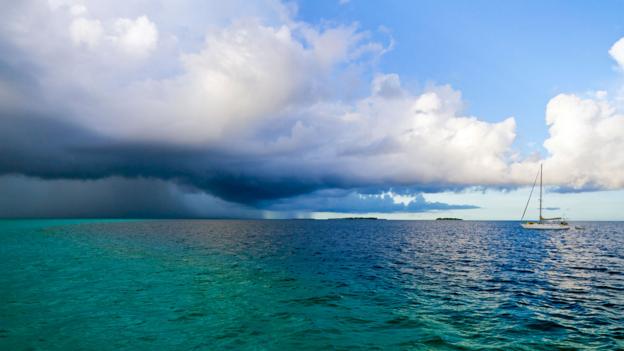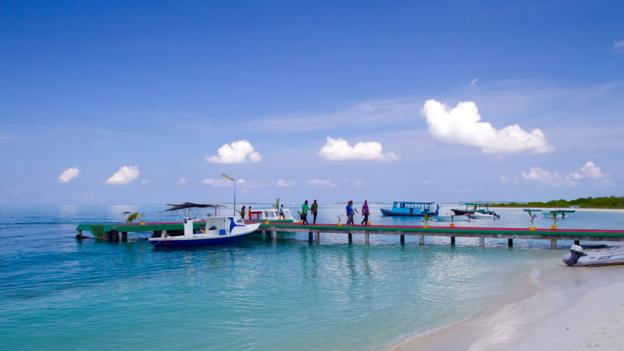I was on the beach, wiggling my toes in fluffy white sand, when a smiling woman brought me a kurrun’baa to drink. I hadn’t requested the coconut, but much like the spinner dolphins that were swimming through the shimmering aqua water just past the reef, the sweet refreshment was perfectly timed.
Every month, some 100,000 luxury-seeking visitors head to the Maldives’ 26 atolls, where thousands of islands promise secluded romance along with adrenalin-filled dives. Once they arrive, almost all of them hop on a plane or boat and speed off to one of the 112 private-island resorts that are scattered like pearls down the country’s 960km length.
But we weren’t at a resort. My family and I were visiting a village, something that less than 2% of the small Indian Ocean republic’s visitors ever do.
Thanks to recent changes in local tourism laws, we were on the remote, reef-wrapped island-village of Kanditheemu in Haa Dhaalu atoll, about 260km north of the capital, Malé. We were discussing the ongoing political upheavals of the nascent democracy with a friendly group of villagers, while also learning about tuna-smoking techniques from Ali, the village’s council president. The smiling lady from the beach, dressed in a long black dress and hijab, was sharing the kind of gracious Maldivian hospitality that would be legendary – if only more people knew about it.
Tourism in the Maldives began when a few Robinson Crusoe-type resorts opened in the 1970s, complete with thatched walls and cold running water. Adventurous divers and surfers soon followed, flocking to the country’s adjacent reefs and surf breaks. As tourism grew – and decadent overwater bungalows gleamed on the horizon – the government began to worry about protecting the integrity of the country’s ancient Islamic culture. After all, the country was fast getting a reputation for being the exclusive playground of royalty and celebrities.
In 1984, it became illegal to stay anywhere other than a resort. “Local” or inhabited islands were strictly off limits.
The laws changed in late 2009, when the first democratically elected president of the Maldives, Mohamed Nasheed, moved to bring some of the profits from tourism to the local communities. His new regulations allowed outsiders to stay on inhabited islands, paving the way for guesthouses, restaurants and Maldivian-owned diving and excursion companies.
One thing that didn’t change was basic Islamic law: on inhabited islands, women are asked to remain covered from shoulder to knee (except for in guesthouses and on council-approved beaches); no alcohol is available outside of the resorts; and you won’t find any pork on your plate – or dogs in the street, for that matter. These things are haraan (forbidden).
Enterprising Maldivians who’d spent much of their working lives as anonymous cleaners at luxury resorts suddenly had a chance to bring all they’d learned – beautiful rooms and sandbar barbeques, whale-watching excursions and mocktail mixology – to the conservative communities they’d grown up in. Between 2010 and 2015, more than 260 guesthouses opened in the Maldives, ranging from basic rooms to elegant boutique inns.
Many are near Malé, on well-known islands such as Hulhumale and Maafushi. But new guesthouses have opened up in the archipelago’s remotest atolls, offering intrepid visitors access to everything from deep-sea fishing with expert local guides to private sunset swims with huge manta rays to empty world-class surf breaks.
As my family and I made our way from the north to the south of the country, I was surprised by how few guests there were at the guesthouses we visited. Manager Jamsheed Hassan said it had taken years after the 2009 law change to save enough money to build the Koimala Inn, the first guesthouse on the South Ari island of Maamigili. He was thrilled when three guests arrived in December 2014, the first month he was open, despite the fact the private-island resorts around him were operating at 90% capacity. Guesthouse locations are gorgeous and many can be sophisticated, but the Maldives lacks a central marketing association for these local accommodations. Getting the word out is up to each owner, with varying degrees of expertise and success.
Koimala Inn is located equidistant from the beach, where foreigners are allowed to swim in bikinis, and from the local mosque, where the call to prayer rings out six times a day. But it was the resident whale shark population that made Hassan decide to open a guesthouse on Maamigili. “People shouldn’t have to spend thousands of dollars at a resort to see the sharks,” he said.
Like most visitors to Maamigili, we had come to see whale sharks and to explore South Ari atoll’s marine protected areas. With extensive reefs – home to some of the country’s 21 species of whales and dolphins – as well as a vast array of colourful tropical fish, we’d been spending most of our visit on, in or under the water.
On one dive, we reached a thila (seamount) at the same time that a resort boat was picking up their guests. In a show of solidarity that’s uncommon among divers, the crew showed us where to start for the best chance of seeing groupers and graceful eagle rays. Dropping into the clear 30C water, we were immediately rewarded when a curious reef shark came over for a closer look. Further into the dive, I peeked into a cave and found myself eye-to-startled-eye with a man-sized grouper and his equally hefty buddy.
When it comes to marine life and beaches, guesthouse visitors and resort guests have the same access. But that’s largely where the similarities end. A week in Koimala, including meals and activities, for example, costs less than a single night in many resorts; and rather than hanging out in a Western-style resort with nightclubs and restaurants, village visitors can immerse themselves in a traditional Islamic community, where entertainment includes Quran reciting competitions and Friday after-prayer dinners.
“I’m responsible for the happiness of my guests, but also for the comfort of the village,” said Hassan as he showed us around Maamigili. Passing shops shaded by breadfruit trees and brightly painted houses half-hidden behind high coral walls, we walked down the hot streets until we reached the rock and sand beach that was set aside for guests.

We continued through a boatyard, where master boat builders construct dhonis (traditional wooden boats)without plans or nails, and past one of the small town’s many mosques. From there, Hassan took us to a colourful, unnamed harbourfront restaurant for a lunch of bajiya (tuna-filled samosas) and mas riha (tuna curry). To finish the meal, Hassan encouraged chewing a little post-meal adafi (a wad of betel leaf and areca nut with a little breath-freshening mint and clove).
With the adafi stuffed awkwardly in my cheek, our talk turned to how guesthouses are received in the villages. Hassan told us more conservative Muslims worry that the outside influence of foreigners will dilute community and religious values. But as a guesthouse proprietor, he’s discovered the opposite is true. While his guests come for the whale sharks and diving, he said, most want to learn about the local culture.
“It’s easy to meet people here and it’s common for villagers to invite you into their homes for snacks or meals,” Hassan said. “Most people who visit end up making friends.”
It’s that opportunity – to meet the people who have long been sharing their home but not their culture – that makes the Maldives special. And that opportunity is reflected in hundreds of smaller moments, like when I was handed a kurrun’baato ward off the heat.
With smiles and giggles I was taught that coconuts actually have 12 different names in Dhivehi, the language of the Maldives, depending on their condition. Turns out, kurrun’baa is a young one, full of cool liquid and promise.

0 comments:
Post a Comment